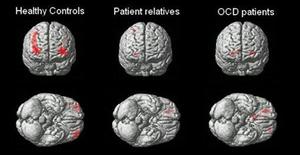
|
| ©REUTERS/Adam Hampshire/University Of Cambridge/Handout |
| Undated brain scans show brain activity in healthy brains and ones with obsessive compulsive disorder. |
The discovery could allow researchers to diagnose the debilitating disorder much earlier and better track how drug treatments are working, they reported in the journal Science.
"The main finding is that in people with obsessive compulsive disorder and their unaffected relatives, part of their orbitofrontal cortex didn't kick in on line as it should have," said Samuel Chamberlain, a neuroscientist at the University of Cambridge, who led the study.
"This is the first study to identify underactive brains in people at risk of OCD."
OCD is a psychiatric anxiety disorder that tends to run in families and is marked by recurrent and persistent thoughts and impulses, such as uncontrollable and repeated hand washing.
It affects about 2 to 3 percent of people worldwide at some point in life.
The study included 14 people with OCD and 12 immediate relatives without the disorder who were asked to complete a task requiring them to be flexible in making certain decisions -- something people with the condition have difficulty doing.
Brain scans measuring activity in the lateral orbitofrontal cortex showed that this region involved in decision-making and behavior did not activate completely in both people with the disorder or their relatives.
Brain activity was normal in volunteers without the disorder.
"If this part of the brain isn't acting as it should it predisposes you to OCD," Chamberlain said. "Previous studies had only shown this in patients, not the unaffected relatives."
The findings could help identify people at risk to provide treatment before symptoms emerge, and lead to a biological marker to determine who is at greatest risk, he added.
Current treatments include Prozac, drug that belongs to a class of compounds called selective serotonin reuptake inhibitors (SSRIs).
U.S. drugmaker Eli Lilly and Co. introduced Prozac in 1987 but the medicine is now off patent and widely available generically as fluoxetine.



Reader Comments
to our Newsletter